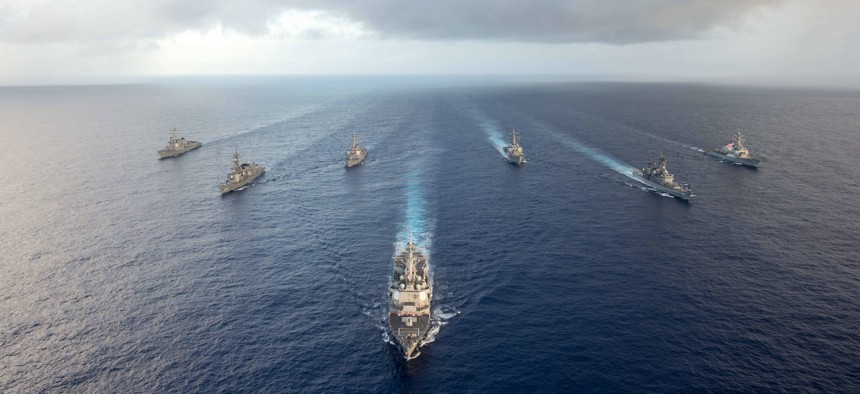
The Arleigh Burke-class guided-missile destroyer USS Mustin (DDG 89) leads U.S. Navy and Japanese ships in formation during MultiSail 17, March 10, 2017, in the Philippine Sea. photo by Mass Communication Specialist 1st Class Elijah G. Leinaar
Trump’s Bigger Military Won’t Necessarily Make the US Stronger or Safer
The Pentagon can’t properly train and support the people and weapons it already has. Simply adding more won’t solve the problem — and could undermine long-term readiness.
As the budget debate kicks into high gear this week, many in Congress and the new Administration are pushing for a substantial increase in the defense budget. Much of the justification for this increase rests on the notion that the military is experiencing a “readiness crisis.” In recent Congressional testimony, the Army noted that two-thirds of its Brigade Combat Teams are not at an acceptable level of readiness because of personnel shortages, maintenance backlogs, and insufficient training. Of those that are ready, the Army says that “only three could be called upon to fight tonight in the event of a crisis.” In the same hearing, the other Services echoed the Army’s claims. The Navy reported that “overall readiness has reached its lowest level in many years,” and the Air Force reported that it is “now able to keep only half of our force at an acceptable level of readiness.”
This is not evidence of a readiness crisis as much as it is evidence of a force structure crisis. The readiness shortfalls cited by the Services are due to insufficient funding to support the number of brigades, flying squadrons, and ships in the force today. The U.S. military is simply maintaining more forces than it can afford at current funding levels.
But the solution some are proposing is to increase the size of the military, which will just exacerbate existing problems rather than resolve them. Adding more forces creates more mouths to feed at a time when the military says existing units are already being starved. More importantly, the strategic rationale for a larger military is unclear. For example, the Trump administration has proposed increasing the size of the active duty Army to 540,000, an increase of 90,000 soldiers above current plans. But the last time the Army grew to that size was to maintain some 185,000 troops deployed to Iraq and Afghanistan. In comparison, roughly 15,000 troops are deployed in Iraq, Afghanistan, and Syria today and three BCTs (roughly 12,000 troops) are deployed as part of the European Reassurance Initiative. The new administration has also proposed increasing the size of the Navy to more than 350 ships and growing the Air Force to 1,200 operationally available tactical fighters.
The push to add force structure appears to be driven by an excessive focus on near-term, quantifiable measures of size. But a larger military and a larger budget will not necessarily make us stronger or safer. Even when the defense budget is growing, implicit tradeoffs must be made because every additional dollar spent increasing the size of the force is a dollar not spent on other priorities. Adding more ground forces and tactical fighters now effectively robs money from long-term investments in forces that can operate over longer distances, such as long-range aircraft, missiles, naval forces, and space systems. Policymakers seem to be jumping straight to a solution without acknowledging the opportunity costs.
President Trump has compared his plans to rebuild the military to the Reagan buildup of the early 1980s. Under President Reagan, the defense budget grew by 36 percent (adjusting for inflation) from fiscal year 1981 to the peak in fiscal year 1985. But the Reagan buildup was largely a weapons buildup, with the procurement portion of the defense budget growing by 69 percent above inflation over the same period. The size of the active-duty military only increased by 3 percent in the Reagan buildup, and the Army did not grow in size at all. A lasting impact of the Reagan buildup was a modernized military with advanced capabilities—things like stealthy aircraft and smart bombs—that continue to provide a strategic advantage today.
But unlike the Reagan buildup, which was guided by a clear strategic rationale, the rush to increase defense spending today could undermine its intent. Spending a billion here and a billion there on weapons and forces that are “shovel-ready” is neither strategic nor effective in the long run. Force structure comes with a long budgetary tail that locks in a share of future budgets to cover the pay, benefits, training, and maintenance costs these forces require. It ties the hands of future military leaders and will drain funding from higher priority capabilities in future budgets.
A frequent saying in the military is that readiness has no constituency. To the contrary, readiness has a powerful and vocal constituency in the form of all who serve today. It is the future that has no constituency. As was the case some thirty years ago in the Reagan buildup, the decisions made today will determine the capabilities available thirty years from now—and most of the men and women who will serve in that future force have not yet been born. Military and civilian leaders are latching on to the idea of a “readiness crisis” in the hopes of securing short-term budgetary gains. But they would be wise to slow down and consider the long-term consequences of how they grow the defense budget.
